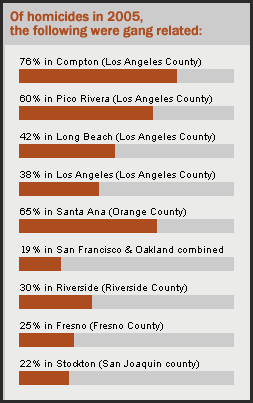 While the Gang Injunction trial wrapped up and we eagerly await Judge Kathleen White’s decision expected in May, we have further evidence that despite claims to the contrary, any gang problems in Yolo County hardly register as a blip on the radar of statewide gang concerns.
While the Gang Injunction trial wrapped up and we eagerly await Judge Kathleen White’s decision expected in May, we have further evidence that despite claims to the contrary, any gang problems in Yolo County hardly register as a blip on the radar of statewide gang concerns.
The DA’s Office argued in their closing that the Broderick Boys gang represented a clear nuisance to the West Sacramento community to the extent that they needed additional remedies not already available under the law.
“My Administration is committed to fighting gang violence with a comprehensive approach that will keep our youth on the right track with early intervention and coordinated anti-gang efforts,” said Governor Schwarzenegger. “These grants will help support California’s local communities to prevent and fight gang violence, making our streets safer.”
According to a press release form the Governor’s Office of Gang and Youth Violence Policy (OGYVP) they received proposals from 36 cities and selected the 24 recipients through a competitive grant process.
Applications were rated by expert panels on the basis of more than 20 objective factors, including the number of gang-related homicides and other crimes, demographic information and use of evidence-based practices. The expert panels were made up of representatives from sheriff, police and probation departments, local government, state grant administrators, schools and community-based organizations. In accordance with state budget language, the City of Los Angeles received $1 million through a non-competitive grant.
“Part of the Governor’s anti-gang initiative is to bring additional resources to our local communities to help combat gang violence and prevent at-risk youth from joining gangs,” said Paul Seave, director of the Governor’s OGYVP. “These grants will assist local anti-gang efforts, particularly those implementing strategies that have been proven to be effective.”
And the amount of money going to Yolo County? Zero dollars. Why not? Well for one thing, no one from Yolo County applied.
In June of this year, the Governor’s office had previously given more than $7.5 million in grants to help at-risk youth avoid gang influence, and once again no one from Yolo County received or applied for grant funding.
According to the county counsel’s office, the county has not applied for a CalGRIP grant in the past few years, but there was a 2009 grant application that was put in by the City of West Sacramento and with which the DA’s Office and the Probation Department provided some assistance
That year, $5.47 million was given in grant money, but not to Yolo County.
The City of West Sacramento asked for $400,000 in state grant money with the hopes of matching it with another $400,000 for an $800,000 project cost.
In their application they argued that there “is a firm belief throughout the county that gang membership is embedded in society due to the established fact that many of the present gang members are second and third generation.”
They made the argument connecting youths, drop-out rates, and crime.
They wrote, “According to Yolo County statistics, as of January 2008, 80% of the youths detained in Yolo County are in custody for gang-related offenses. The county held 345 youths in custody at the juvenile detention center in 2007 and the District Attorney’s Office estimated that 280 of these youths were detained for gang-related offenses and that 8% of high school children in Yolo County are affiliated with a gang.”
They also talked about the injunction that was put into place for the first time on February 3, 2005.
Chief Dan Drummond, the signatory on the grant application, wrote, “This injunction was meant to send a clear and immediate message that there would be a concentrated law enforcement presence within the “Safety Zone” and that any acts forbidden by the injunction would be met with a “no-tolerance” response.”
Chief Drummond declared on May 23, 2007 that “the permanent injunction was successful in reducing crime in the Safety Zone during the period of its enforcement.”
Indeed, he cited Stacie Meyer, Crime Analyst for the West Sacramento Police Department, who stated, ” .. . I analyze crime trends and produce reports showing changes in crime rates in the City of West Sacramento. In 2006, there was a 2% drop in violent crime city-wide since 2004 compared to a 7% drop in the neighborhoods of Broderick/Bryte during the same time period.”
But from a statistical standpoint that may not be all that meaningful, especially if it is a two-year trend. First, statewide crime statistics all dropped over that period. Second, if the Broderick/Bryte area is the higher crime area to begin with, it would be unsurprising to see a larger drop in crime there as opposed to parts of town with low crimes rates.
Third, and perhaps most important is the problem of separating the impact of the injunction from other changes that occurred. The City of West Sacramento over the last decade has put millions into redevelopment, including tearing down crime-infested areas along West Capitol Ave.
How does one separate the impact of one intervention over another? Using advanced statistical methods it would be difficult, but not impossible to do. Using the type of comparative statics method apparently employed by the crime analyst, it is virtually impossible.
Chief Drummond also disparages the community members who have apparently complained about West Sacramento tactics.
Chief Drummond adds, “Unfortunately, the original Injunction was vacated July 23, 2007 as a result of pressure exerted, especially from families living within the “safety zone” area who are either members or related in some way to a gang member.”
This was the basis for the attempts by the DA’s Office to discredit the residents who came to testify against the gang injunction, by saying that they were either gang members or related in some way to gang members. This is perhaps part of the problem with enforcing a gang injunction in areas like Broderick and Bryte, which are old neighborhoods with close-knit family structures. Everyone is somewhat closely-related to everyone else.
“Complaints included that certain ethnic populations were being targeted and that other freedoms were being curtailed,” the Chief continued. “Although some citizens take a dim view of law enforcement curtailing activities, the Injunction is not directed at any specific race, it is directed at a specific criminal element in the community. The Injunction is directed toward intervention and prevention.”
However, one of the chief problems raised during the gang injunction is that many residents do believe that people are targeted on the basis of race and ethnicity. After all, while Nortenos may be of any race or ethnicity, the majority are believed to be Hispanic and many residents believe that the police have used the gang injunction as a means to harass Hispanics.
The 2009 application suffers from similar problems to what the plaintiffs in the gang injunction trial faced. The signature events, in this case the attack on the engineer and conductor of the Amtrak train, was a non-fatal attack. And so was the Memorial Park incident which had not yet occurred until after the 2009 application.
And so the CalGRIP grant looks in part at reducing homicides. The Governor’s office presented stats on the percentage of homicides that were gang-related.
 The “problem” in West Sacramento is that there are very few homicides each year. In fact, countywide there may only be a handful or two in a given year. That is a problem only when the leadership in the county is trying to make the case that there is a widespread gang problem.
The “problem” in West Sacramento is that there are very few homicides each year. In fact, countywide there may only be a handful or two in a given year. That is a problem only when the leadership in the county is trying to make the case that there is a widespread gang problem.
The application is complete with letters of recommendation from various leaders in the county.
For instance, then Assemblymember Lois Wolk wrote on November 21, 2008, shortly after her election to the Senate, “West Sacramento Police Department has consistently demonstrated a dedicated and determined effort to combat crime, provide service, and improve the quality of life for the citizens of West Sacramento. Funding for one full-time Officer, one full-time Enforcement Officer and for youth programs established by the Collins Teen Center will greatly assist us in expanding these efforts to reduce gang activity and participate in intervention and prevention.”
Jorge Ayala, County Superintendent of Schools submitted an identical statement, writing, “West Sacramento Police Department has consistently demonstrated a dedicated and determined effort to combat crime, provide service, and improve the quality of life for the citizens of West Sacramento. Funding for one full-time Officer, one full-time Enforcement Officer and for youth programs established by the Collins Teen Center will greatly assist us in expanding these efforts to reduce gang activity and participate in intervention and prevention.”
There are some worthy components of the CalGRIP program. Governor Schwarzenegger, in 2007, introduced his CalGRIP initiative to “confront the dramatic increase in gangs across the state and their proliferation in suburban and rural areas. CalGRIP combines funding from different programs and directs it towards local anti-gang efforts focused on intervention, suppression and prevention.”
The grants recently awarded were the fourth round of grants. The grant awarded in June for instance, focused on job training and other ways to help at-risk youths better avoid crime and violence.
“Early intervention and guiding our at-risk youth toward jobs and careers will help them become more self-sufficient and productive members of their communities,” said Governor Schwarzenegger. “This funding will answer a pressing and immediate need to provide at-risk youth with a productive alternative in the summertime, and we are also thinking long-term to combat and prevent gang-related crime through our coordinated efforts in CalGRIP.”
“The long-term answer to gang violence requires investing in job training and education,” said Governor’s Office of Gang and Youth Violence Policy Director Paul Seave. “These grants have the refreshingly high but reasonable expectation that gang-involved youth have what it takes to complete high school and college and embark on a teaching or social service career, if there is effective support.”
—David M. Greenwald reporting





Ted Puntillo’s tenure as Davis Councilperson was characterized by open contempt for the will of the Davis voters. It is not surprising that he now supports Souza who,we remember, bellowed from the dais,”WE(on the Council dais) are the decision-makers!!” Candidate Joe Krovoza pledged to have the Davis voters MORE involved planning the future of their city
Maybe as you pointed out they knew they didn’t have the stats to get the grant. Of course this does not mean that anti-gang intervention isn’t needed. It is, we need both positive efforts to fight gangs and we need the law to be enforced to get criminal gang activity off the street.
dmg: “And so the CalGRIP grant looks in part at reducing homicides.”
Does it include “attempted murder” or must the victim be deceased for the statistic to be counted for the grant application?
Does the Collins Teen Center exist, and if so, how is it doing? Some commenter (“valerie”) indicated there were no teen programs in West Sac, if I am remembering her comment correctly…
Personally, I find it somewhat reassuring to know that Yolo crime stats DO NOT warrent an application for a CalGRIP grant…
[quote]Personally, I find it somewhat reassuring to know that Yolo crime stats DO NOT warrent an application for a CalGRIP grant… [/quote]
Although it may be nice that the crime rate does not justify gang grant money, what does that say about how much time, effort, propaganda and tax money as been wasted by DA Jeff Reisig to confuse and promote his lies to get this gang injunction passed and to try and mislead the people he is suppose to be representing?
Let me get this straight, the state gets a panel of experts and they say Yolo does not have a big enough gang problem to justify a grant, yet Reisig gets the press to put out his reckless and misleading press releases to try and fool the people on what a great job he is doing with this so called huge gang problem. More deceit and poor leadership by Mr. Reisig, what a surprise.
[quote]Let me get this straight, the state gets a panel of experts and they say Yolo does not have a big enough gang problem to justify a grant, yet Reisig gets the press to put out his reckless and misleading press releases to try and fool the people on what a great job he is doing with this so called huge gang problem. More deceit and poor leadership by Mr. Reisig, what a surprise. [/quote]
I don’t see anywhere in this article that says the gang problem in Yolo County doesn’t warrant grant money. The CalGRIP grants were not applied for. The panel of experts didn’t consider Yolo for those grants. Try a thought process other than the Reisig conspiracy theories one might find that even IF the grants were applied for there were other areas with a larger gang problem.
[quote]there were other areas with a larger gang problem.[/quote]
Exactly, and these other areas DO NOT all have injunctions and I would bet the ones that got grant money do not all have injunctions. So my point that obviously went pass you, is Reisig keeps screaming how bad the gang problem is, if that is so, why did they not apply, why did not get it?
So try a thought process that does not just blindly protect and support our crooked DA.
I didn’t see anything that says gang injunctions were considered. Maybe they should use their new grant money to get an injunction, then they wouldn’t need grant funding. Just a thought.
My thought process doesn’t lead me to blindly support our DA. It leads me to wait for one piece of evidence, instead of conjecture, before I label someone as corrupt.